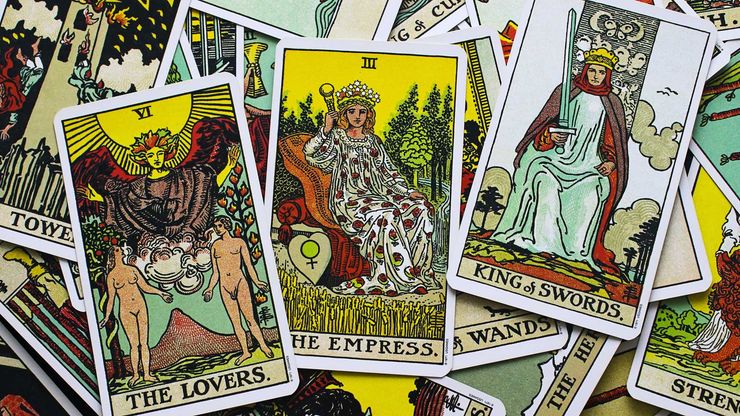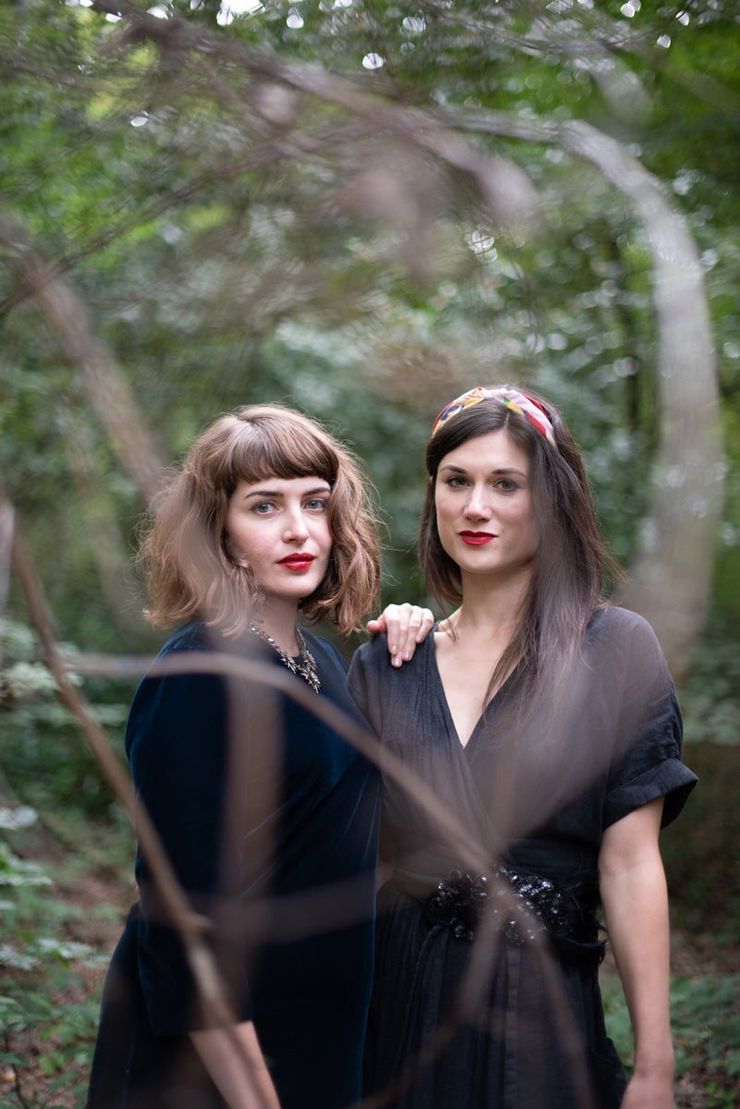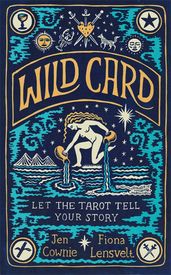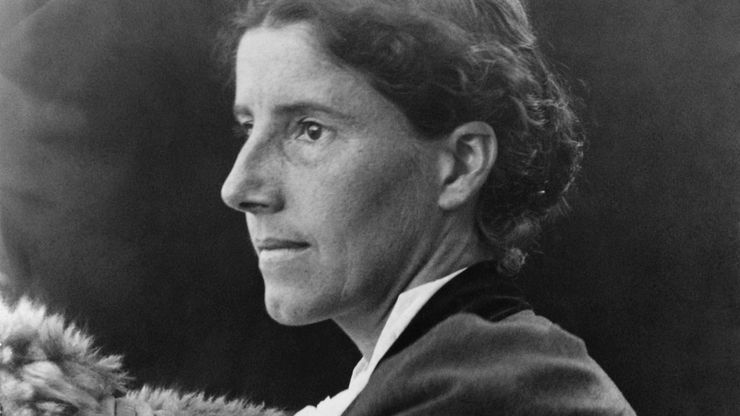Everything you need to know about tarot cards
From how to get started to which tarot deck to buy, Jen Cownie and Fiona Lensvelt – tarot readers and authors of Wild Card: Let The Tarot Tell Your Story – share everything you need to know about the tarot.

Jen Cownie and Fiona Lensvelt discovered a shared love of tarot in their twenties. Allured by its rich visual symbolism, they quickly became immersed in the stories the tarot contains and the ways in which those stories can help people make sense of the full range of human experience. And they're not alone.
In 2018, Fiona told the Guardian: 'There’s a real sense of community in using it, particularly among younger women. People think it’s about predicting the future, but it isn’t. It’s about the present, and it can be very empowering . . . tarot allows you to consider a problem, give a voice to it, work it through and see where the blocks might be. It can give voice to problems or fears.'
Fast forward four years, and our collective interest in tarot has only grown. While some tarot card readers might be looking for certainty in uncertain times, and others looking for new ways to self-reflect, either way, tarot cards have become a tool for our time.
Here, Fiona and Jen, now authors of their own guide to the cards, Wild Card: Let The Tarot Tell Your Story, share all there is to know about the art, from how to get started reading tarot cards to which deck to buy.

Who can read tarot cards?
We made our first foray into tarot several years ago now. We had no idea what learning the tarot would be for us - a party trick? A new hobby? A fun story to tell our friends? Something more? All we knew was that we were fascinated by the idea of these beautifully illustrated cards and their symbolism. We wanted to know how they worked and if we could use them too.

One of the most common questions we get asked is “how do you become a tarot reader?” Over time, we’ve realised that many people ask us this because they’re worried that unless you have some sort of occult pedigree, you’re not going to get very far with it. So, as two entirely non-psychic tarot readers who came to the practice in our late twenties, allow us to be the first to tell you that this is nonsense.
The tarot is for everyone, and anyone can learn to read it. It’s for you, too, if you want it to be. As we’ve discovered in our own journey with tarot, there is no one type of person who reads the cards or comes for readings. People of all ages, from all walks of life and with all professional backgrounds have been known to dabble with the deck. For some, reading tarot intersects with other practices: spellcraft, astrology, crystal work, divination. But for many others, it doesn’t. In fact, the way that people use the deck is entirely personal. You are allowed - no, encouraged! - to find your own relationship with the cards, on your own terms.
If you're curious about whether tarot is ‘real’ . . .
For us, the magic of the tarot is less about fortune-telling and more about stories. Our practice is entirely secular: we don’t offer readings that have any kind of psychic element to them. We don’t believe that the tarot can tell you exactly what to do - and more importantly, we think this is a good thing. What we’ve come to love about the tarot is the narrative power of the cards, the way that their symbolism invites questions and self-reflection, and so empowers you to make your own decisions about the direction you want your future to take.
The interplay between different cards can offer up new perspectives, challenge old and unhelpful ways of thinking, or even just force you to acknowledge things that you’ve been hiding from yourself (thanks, tarot). That doesn’t mean the cards aren’t helpful when it comes to making decisions or thinking about the path ahead. But it does mean that the way they help isn’t quite what popular culture has led us to expect.
How do tarot cards work?
When you lay out all of the cards in a tarot deck, you find all of life hidden within them. The tarot is made up of two sections called the Arcanas (the word means “secrets”) - there’s the Major Arcana, which contains 22 cards, and the Minor Arcana, which contains 56.
Within the Minors, you find four suits, just as you would in a regular pack of playing cards, but with the difference that each suit is associated with a different element and aspect of the self. The suits are:
- The Cups, associated with water and the emotional self.
- The Pentacles, linked to earth and the physical self.
- The Swords, the cards of air, which are all about the mind.
- And the Wands, the suit of fire, which are about how you apply your energy.
Meanwhile, the journey of the Major cards contains seismic shifts in life, telling a dramatic story of beginnings and endings, discoveries and losses, stillness and growth. It is often the Major Arcana cards that newcomers to tarot recognise - The Hanged Man, for example, or The Lovers. And when you combine all of these different cards you’ve got all of the ingredients for a thousand unique narratives.
What to look for in a tarot deck

If you are looking to take that leap into tarot, you might be wondering what to do first. We would highly recommend you start by buying a tarot deck - yes, you can buy your own, and also it can definitely be second hand. There are a lot of decks out there so choosing yours can be more easily said than done.
The earliest tarot decks date back to the fifteenth century, which means there has been plenty of time for innovation, and the card designs have passed through thousands of hands and paintbrushes. The closest thing that exists to a standard tarot deck is the Rider-Waite (or Rider-Waite-Smith, as we prefer to call it, to credit its illustrator Pamela Colman-Smith). The deck actually dates from the turn of the twentieth century so it’s by no means The Original, but it’s the one on which the vast majority of other deck designs and structures are now based. It’s also easy to get hold of and among the more affordable options, so it can be a good starter deck.
The Rider-Waite-Smith isn’t the only option, though. There’s no limit to how many decks of cards you can have - some people prefer just to own one, some people (hi) have a whole shelf full. The most important thing is to find something that speaks to you, whether that’s in terms of its design, its concept, or its creator: there are many decks by BIPOC and queer creators, for example, which reimagine the largely cis, heteronormative, and white imagery of the Rider-Waite-Smith.
If you’re getting started, though, it’s definitely worth seeking out a deck which follows the most common structure: i.e. 78 fully illustrated cards. If something is listed as an oracle deck… that’s a no, because that’s not tarot, no matter how pretty it is. Similarly, if you see the words “pip deck,” save it for later. That is a tarot deck, but it’s one where 56 of the 78 cards aren’t illustrated, and therefore really, really hard to learn from.
How to read with tarot cards
Readings can be performed for oneself or for others, and they all follow a similar format: the reader shuffles and fans out the deck face down, and then invites the querent (that’s the person being read for, it means “the one who seeks”) to pull a series of cards. The cards are laid out on a flat surface in a specific pattern, known as a spread. Each position in the pattern has a different significance, and the meaning of the card has to be read through that lens: for example, you might pull a card to signify your past, or something that’s holding you back, or a hidden strength. The reader should take the lead in interpreting the cards, building a narrative from the symbols in front of them - but many also invite the querent to participate, asking questions and inviting them to share their reactions to the images in front of them.
Almost needless to say, tarot readings are very intimate and very personal. The most important thing to remember is that a reading is always about the querent, not the tarot reader. This is not the time for showboating! If you’re reading for someone else, you’re in a position of trust. They might share things with you that they’ve not told other people, or that they’ve not even realised about themselves before. Sometimes, it can be a cathartic experience. Sometimes, it can be absolutely hilarious. And sometimes: baffling. If you’re curious to learn tarot, we’d always recommend starting out by reading for yourself or for someone who you know well, and only graduating to readings for strangers once you’re steady on your cartomancy feet.
Of course, before giving readings you will need - and this is no small task - to have learnt the cards. Sorry, no shortcuts. Many find that a guidebook is the best place to start: it allows you to learn at your own pace, and is a bit less of a commitment than weeks and weeks of tuition. A good guide to the tarot will help you to become familiar with the overall shape of the deck, the symbols associated with each of the cards, and the commonly held meanings, as well as providing practical advice and tips on spreads, learning techniques, and reading etiquette. There are quite a few excellent books out there, but for the purposes of this article, may we humbly draw your attention to this one.
Telling your own stories with tarot cards
Lastly, but by no means least, learning tarot means learning how to apply your own unique experiences and perspectives to each of the cards. You’ll learn that the Death card connotes change and endings - but what does that bring up for you personally? If you draw The Hermit, ask yourself how you’ve used and benefited from periods of solitude. Over time, you’ll begin to see the cards everywhere: in day-to-day moments, in fragments of poetry or song, in characters from Netflix series. You might find that some cards become imbued with a specific meaning that feels unique to you. That’s not wrong. In fact, it’s the lifeblood of this ancient practice.
The tarot survives because it stays relevant for each new generation. The images on the cards are symbols, not signposts: they can never be pinned down, or fixed, or owned. They are big enough to carry every life, every experience, and every story within them. So, more than anything, when you learn and read the cards, don’t be afraid to make them your own - and share what you find there.
Wild Card

At its heart, the tarot is a storytelling device, a deck of symbols and narratives that can spark conversations, inspire ideas, and reveal new perspectives. And you don't need to be psychic to use it: it is a practice that is open to everyone. In this beautifully illustrated guide, tarot readers Jen Cownie and Fiona Lensvelt introduce each of the cards, drawing on literature, pop culture, and their own experiences, and encourage you to add your voice to this centuries-old tradition.
Whether you are learning to read for yourself and others, refreshing your knowledge, or just curious, Wild Card will show you how the tarot can add a little bit of magic to your life.


